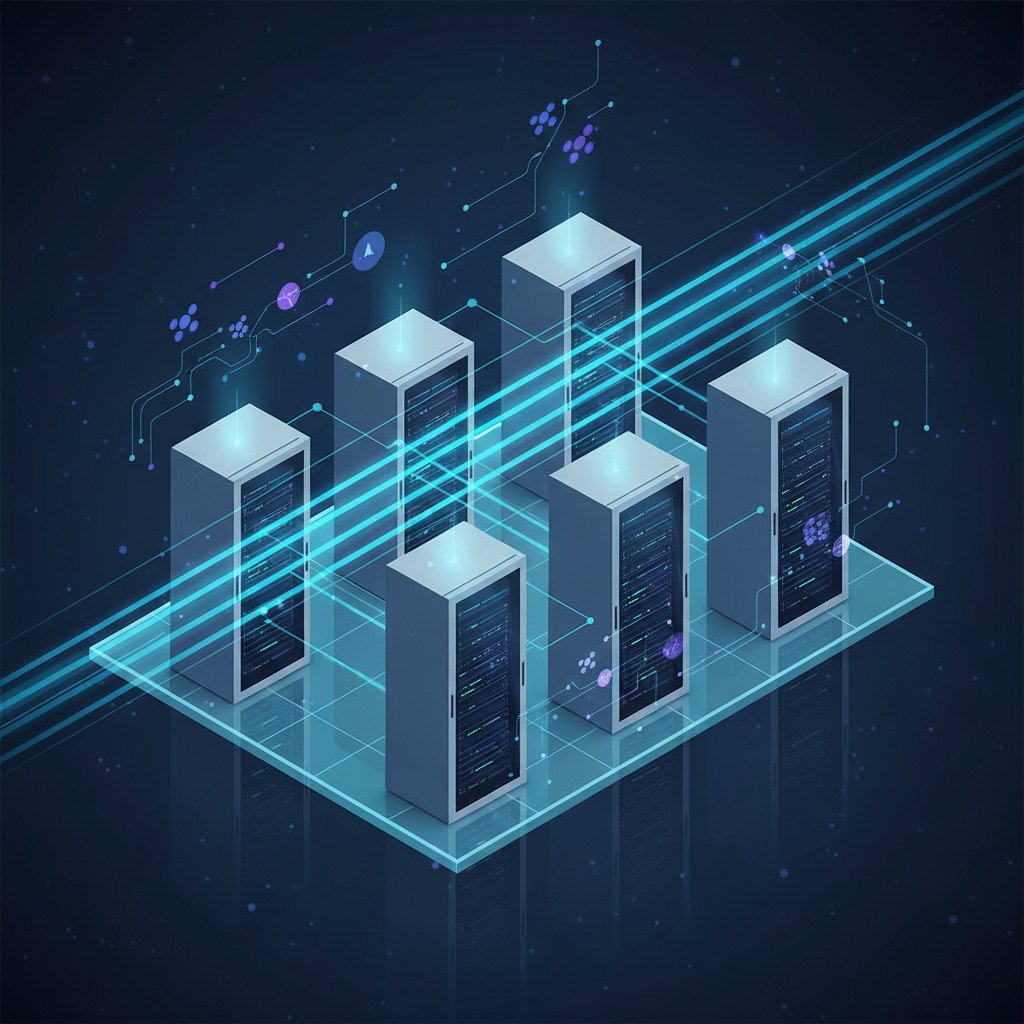Cisco AI readiness and AI data centre interconnect: Why data centres must evolve
Cisco AI readiness and AI data centre interconnect are not optional anymore. Enterprises need networks that scale, secure AI agents, and move models from pilot to production. However, only a small share of firms meet that bar. Many face AI infrastructure debt because they lack GPUs, cohesive AI roadmaps, and high-bandwidth links.
Because AI workloads will surge, data centres must adapt. Cisco leads with router and interconnect tech that supports 51.2 Tbps-class fabrics, coherent optics, and deep buffering. Moreover, Cisco’s approach aligns with AI readiness index findings: pacesetters design networks for AI and see faster pilot-to-production transitions. Therefore, leaders can reduce latency, manage GPU power, and scale across sites securely.
This article breaks down where most enterprises fall short, and how Cisco’s stack addresses common gaps. We will cover AI network scalability, AI infrastructure security, and practical steps to build an AI roadmap. As a result, you will know what to prioritize to move from experimentation to measurable value.
Cisco AI readiness in modern data centres
Cisco takes a network first approach to AI readiness because data movement defines performance. Cisco combines high‑capacity routing, coherent optics, and intelligent software to deliver predictable latency across distributed AI clusters. Therefore, the company focuses on end to end design that links GPUs, storage, and cloud fabrics securely and at scale.
For example, Cisco’s 8223 routing system and Silicon One P200 family aim to support 51.2 Tbps fabrics and long‑haul data centre interconnects. Moreover, Cisco pairs open and proven software stacks such as SONiC and IOS XR to simplify operations, while offering deep buffering and 800G coherent optics to reduce head‑of‑line stalls. As a result, organisations can move pilots into production faster and cut AI infrastructure debt.
Key technologies
- 51.2 Tbps routing and 8223 system for scale and throughput
- Silicon One P200 ASICs for consistent latency and multi role use
- 800G coherent optics and deep buffering for long‑distance DCI
- SONiC and IOS XR for operational automation and observability
- Integrated security controls to manage AI agents and data flows
Benefits and outcomes
- Faster pilot to production cycles and higher model ROI
- Predictable latency for multi GPU workloads across sites
- Simplified operations through standardized ASIC and SW stacks
Challenges and trade offs
- Many enterprises still lack sufficient GPU power, therefore they underprovision compute
- Data fragmentation complicates DCI, because data must be consolidated for training
- Integration costs and skills gaps slow adoption, however pacesetters overcome these with clear AI roadmaps
For further context on AI readiness benchmarks, see Cisco’s AI Readiness Index and Cisco’s data centre AI networking guidance. Also compare networking approaches such as NVIDIA Spectrum X for AI data centres in our inbound analysis.

AI data centre interconnect: how AI accelerates DCI and Cisco innovations
AI transforms data centre interconnect because it demands predictable throughput and low latency. Cisco applies telemetry, intent based networking, and ASIC‑level consistency to tune links for AI traffic. Therefore, interconnects become smarter and more efficient at moving large model weights and training data across sites.
Cisco innovations focus on hardware and software working together. For instance, the 8223 routing system and Silicon One P200 provide high capacity and consistent latency for distributed training. Moreover, SONiC and IOS XR add automation, observability, and policy controls so teams scale DCI without adding manual toil.
How AI enhances DCI
- Telemetry driven path selection reduces congestion because AI flows are latency sensitive
- Predictive buffering and flow steering avoid packet loss during large tensor transfers
- AI based telemetry automates capacity planning for GPU clusters
Cisco specific capabilities
- 51.2 Tbps routing platforms for high throughput interconnects
- 800G coherent optics and deep buffering for long distance links
- Unified software stacks for zero touch provisioning and observability
- Integrated security to control AI agents and data movement
Benefits for network efficiency and scalability
- Higher utilization of expensive GPU resources because networks reduce stalls
- Faster time to production since networks meet pacesetter requirements
- Simplified operations and lower total cost of ownership through standard ASICs
However, challenges remain. Many organisations lack enough GPUs and suffer data fragmentation, therefore DCI alone cannot solve readiness. For broader context on alternative DCI approaches, compare NVIDIA Spectrum X coverage in our inbound analysis and Cisco’s AI Readiness Index and 8223 announcement for technical details NVIDIA Spectrum X review, Cisco AI Readiness Index, Cisco 8223 announcement.
| Feature | Cisco | Juniper Networks | Arista |
|---|---|---|---|
| Core strengths | High capacity routing, 51.2 Tbps platforms, Silicon One P200, SONiC and IOS XR | Strong WAN optimizations, routing and telemetry with Mist AI integration | Programmable switches, EOS software, strong visibility for cloud fabrics |
| Benefits | Predictable latency, deep buffering, integrated security, operational automation | Simplified operations, AI driven Wi Fi and WAN insights, service provider focus | High programmability, low latency leaf spine fabrics, cloud-native integrations |
| AI integration level | High because of ASIC consistency, telemetry and intent based networking | Medium to high via Mist AI and Contrail automation | Medium high via EOS and cognitive telemetry tools |
| Scalability | Very high for distributed training and DCI because of 800G optics and 51.2 Tbps routing | High for multi site WAN and campus, modular for DC expansion | High within leaf spine domains and cloud interconnects, scales well horizontally |
| Enterprise use cases | Distributed GPU training, secure multi site DCI, pilot to production pipelines | Global WAN for hybrid AI pipelines, managed services, campus to cloud AI agents | Hyperscale cloud fabrics, edge aggregation, low latency inference fabrics |
Key takeaway
Cisco emphasizes end to end networking for AI workloads. Therefore, it suits organisations prioritising scale and predictable latency. However, Juniper and Arista offer competitive strengths for WAN optimisation and cloud native fabrics. As a result, enterprises must map workloads, GPU requirements, and data gravity to vendor capabilities. Use this table to prioritize features and vendor fit for your AI roadmap.
Conclusion: Cisco AI readiness and AI data centre interconnect
Cisco AI readiness and AI data centre interconnect matter because networks determine whether AI delivers value. Cisco’s integrated approach reduces latency, secures AI agents, and lets teams scale distributed training across sites. Therefore, enterprises that prioritise network design can move pilots into production faster and extract measurable ROI.
Companies benefit in three clear ways. First, they gain predictable performance for multi GPU workloads, which reduces wasted GPU cycles. Second, they simplify operations through standardized ASICs and unified software, therefore lowering operational cost. Third, they secure data and agents with built in controls, so teams can deploy AI safely at scale.
EMP0 supports organisations that want to adopt Cisco AI readiness strategies. Our AI and automation solutions help run AI powered growth systems securely under client infrastructure. Moreover, EMP0 provides implementation support, automation pipelines, and observability to accelerate pilot to production transitions. Visit emp0.com and follow our blog at articles.emp0.com for technical deep dives and case studies. Connect with us on Twitter X @Emp0_com and see longer form posts on Medium at medium.com/@jharilela.
Ready to move from experimentation to production? Explore EMP0 offerings and partner with experts who align network, compute, and data to unlock AI value.
What are the main benefits?
Cisco’s approach delivers predictable latency, higher GPU utilisation, and unified operations. Therefore, teams accelerate pilot-to-production and extract measurable AI value.
What implementation challenges should I expect?
Challenges include insufficient GPU capacity, fragmented data, and skills gaps. However, clear roadmaps, DCI upgrades, and automation reduce risk.
How does Cisco secure AI agents and data?
Cisco integrates policy controls, telemetry, and segmentation to limit agent access. This approach helps enforce governance while maintaining performance.
Do I need more bandwidth or compute first?
Both matter, but start by assessing data gravity and GPUs. Then, prioritize interconnect upgrades if datasets span sites.
What future trends will affect DCI?
Expect smarter telemetry, 800G optics, and intent-based automation. As a result, networks will scale dynamically with AI workloads.
For implementation help, consult Cisco partners or EMP0 for tailored assessments. Start with an AI readiness audit.

